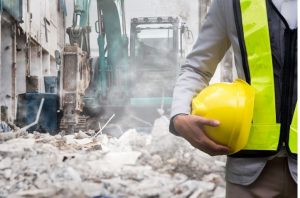Hot Weather Safety Tips for Aerial Lift Workers
With the warmer weather of spring and summer quickly approaching, it’s time to start thinking about working outdoors in the heat. Heat stress and heat stroke are some of the most common types of illness-related accidents for construction, forestry and utility workers during the summer. Like most workplace accidents, heat stroke and heat stress can be prevented with the proper training and equipment. Here are some tips to make working during the heat of summer, just a little cooler.

Modify Your Work Schedule
For supervisors, this may seem challenging, but on those extremely hot days, it’s safer for you and all of your workers, especially those spending time in aerial lifts, to consider a lighter work schedule. What does this mean?
- Plan heavy work during the coolest part of the day.
- Limit the time workers spend exposed to direct sunlight, especially utility workers that are maintaining lines from aerial lifts.
- If possible, work at night when it’s cooler and when the exposure to the sun is limited.
- For forestry workers, do tree trimming work in the morning, to protect both you and the trees you’re working on from the heat.
Take Frequent Breaks
This is really important for protecting workers from heat illness. During the heat of summer, make sure that employees are taking plenty of time to rest and find shade or a place to cool down. For aerial lift workers who don’t have access to shade, it’s important that you frequently come down from your lift and take shelter under a canopy or in the air conditioned cab of your vehicle. Keeping your body cool and near a normal temperature is the first step to avoiding heat illness.
Stay Hydrated
Drinking water and keeping the internal temperature of your body regulated is very important to working safely during the summer. If your aerial lift basket has space, bring your water with you. Otherwise, come down from your lift frequently for water breaks. Don’t guzzle your water, take small drinks frequently, or about 1 cup of water every 20 minutes. You may want to supplement your water with diluted energy drinks like PowerAde or Gatorade to replenish electrolytes. Whatever you do, definitely avoid alcohol, soda and caffeinated beverages, since these can dehydrate you very quickly.
Wear the Right PPE
Construction and utility workers need to have the correct clothing and Personal Protective Equipment (PPE) for summer work. This includes:
- Long-sleeve shirts
- Long pants
- Brimmed hats
- Sunglasses
- Light-colored clothing
- Sunscreen
Work in Teams
It’s very important that when you’re outdoors working in the summer that you don’t work alone. For aerial lift workers, this is a great way to limit the time exposed to heat. You and your partner can take turns working in the lift and cooling down. It can also be difficult to tell on your own if you are suffering from heat illness, and it’s often easier for a coworker to tell if you are starting to be impacted by the heat.
Get Trained
Construction, forestry and utility workers, especially those that spend time in aerial lifts should be well trained in how to work safely in the summer. This training should include the tips provided here, as well as training in recognizing the signs of heat illness (dizziness, nausea, accelerated heartbeat, confusion) and basic first aid for treating heat illness.
For those working in industries mentioned above, working outside in the summer is a necessary part of the job. However, with the right training, work schedule and plenty of smarts, working outside can be cool and comfortable for everyone.
About the Author
CertifyMeOnline.net is the number one online resource for OSHA-compliant training for employees that operate aerial lifts and scissor lifts. The safety and equipment experts behind CertifyMeOnline.net know how important good, OSHA-compliant training is for business owners, and how challenging it is to schedule onsite training. CertifyMeOnline.net is the easy way to certify and train all of your employees without any downtime.
Sources:
https://www.unitedrentals.com/project-uptime/productivity/warmer-weather
https://www.osha.gov/OshDoc/data_Hurricane_Facts/working_outdoors.pdf
https://www.osha.gov/SLTC/heatstress/prevention.html














